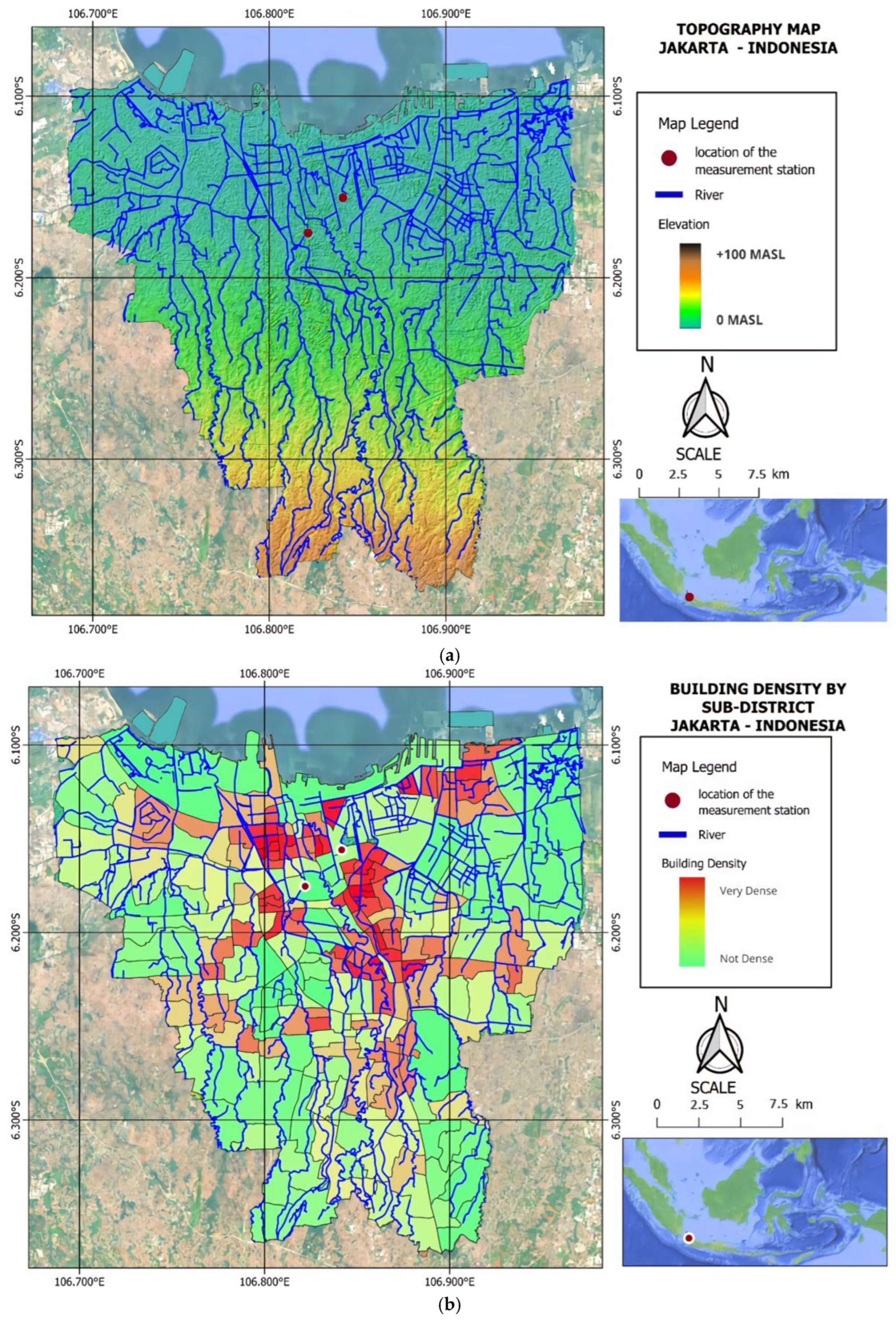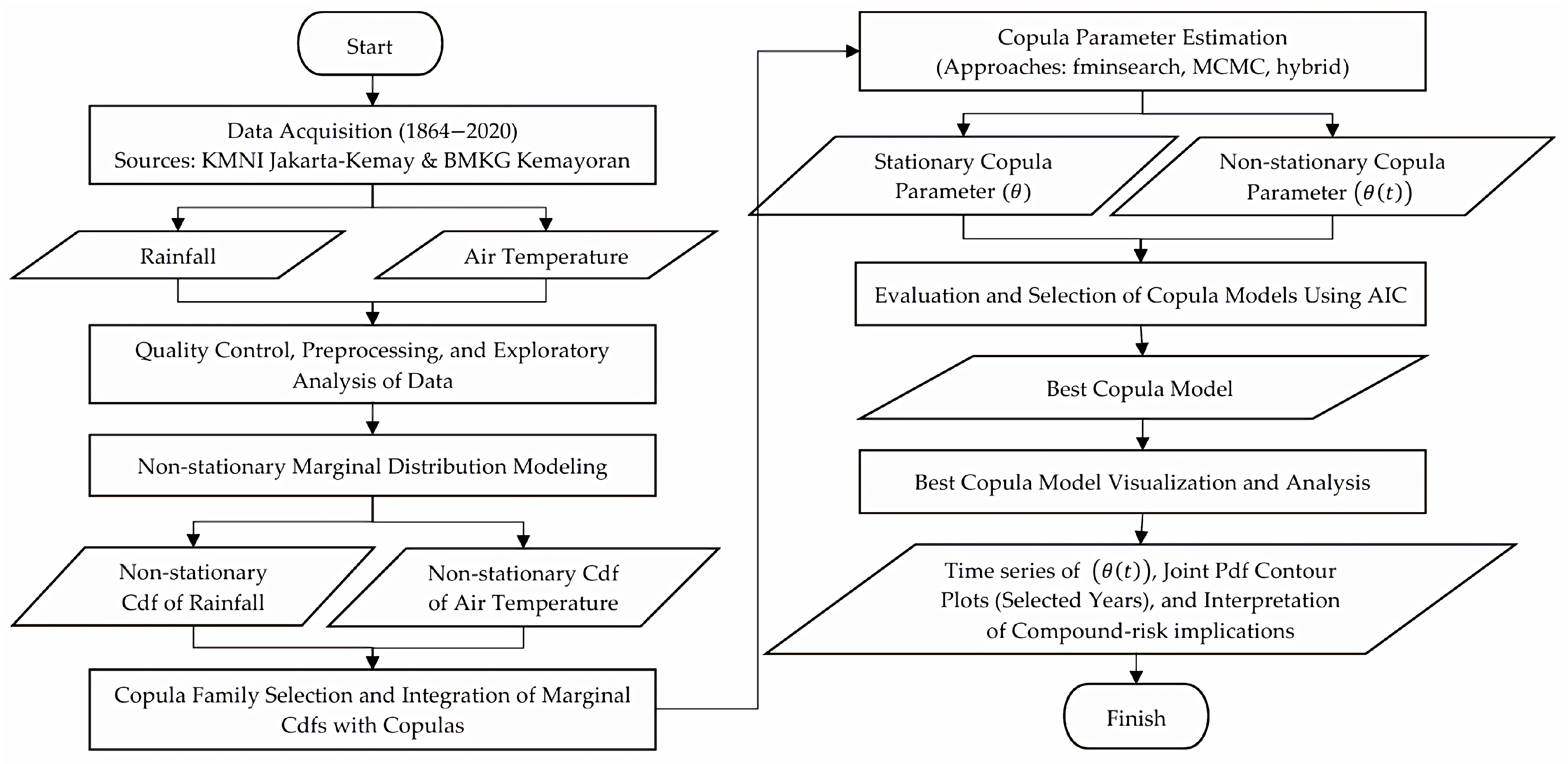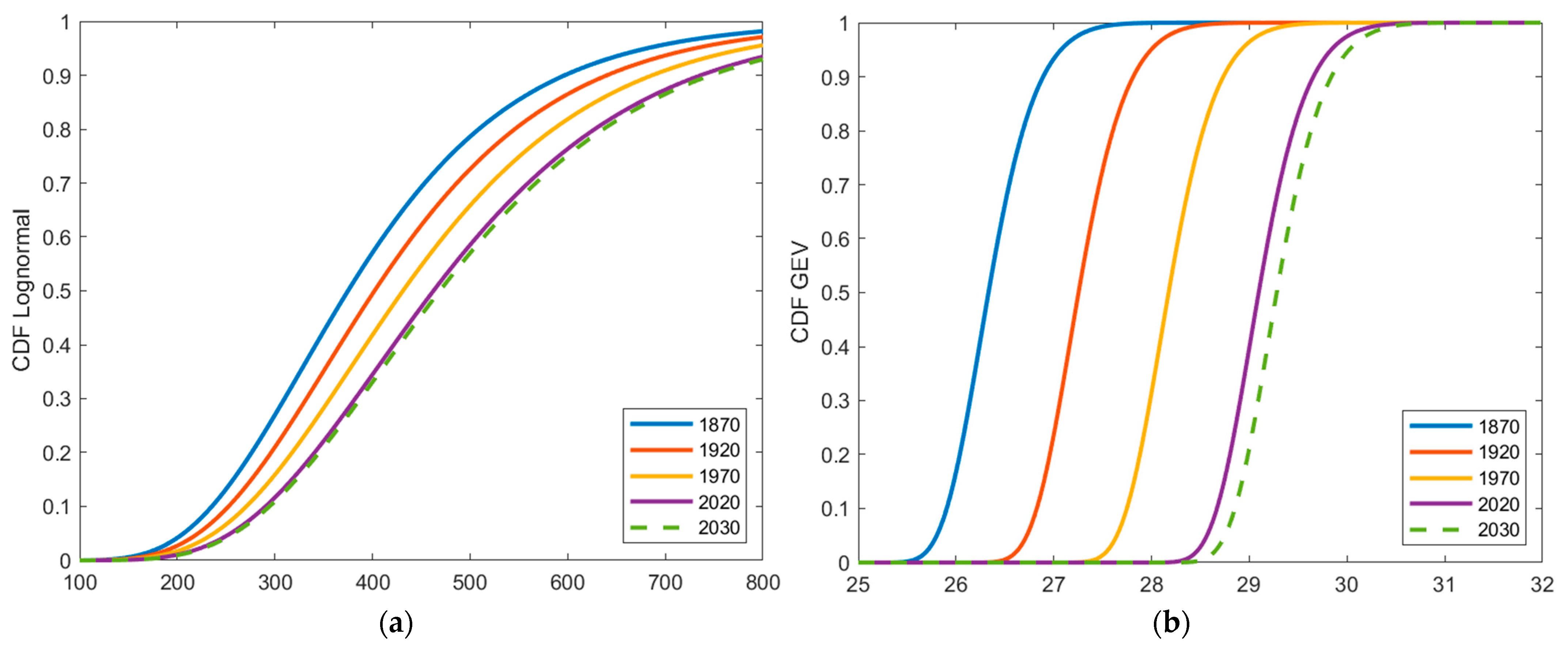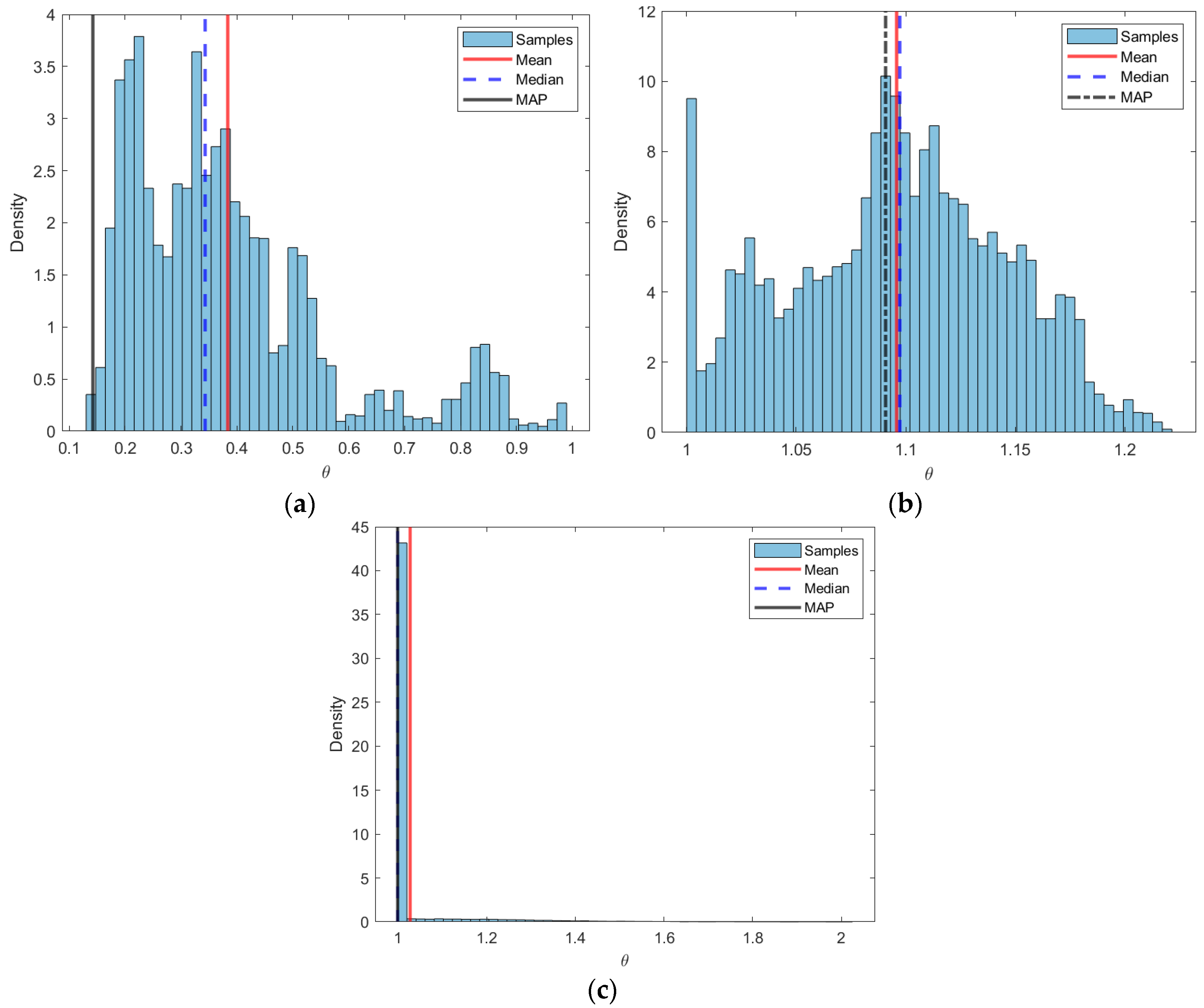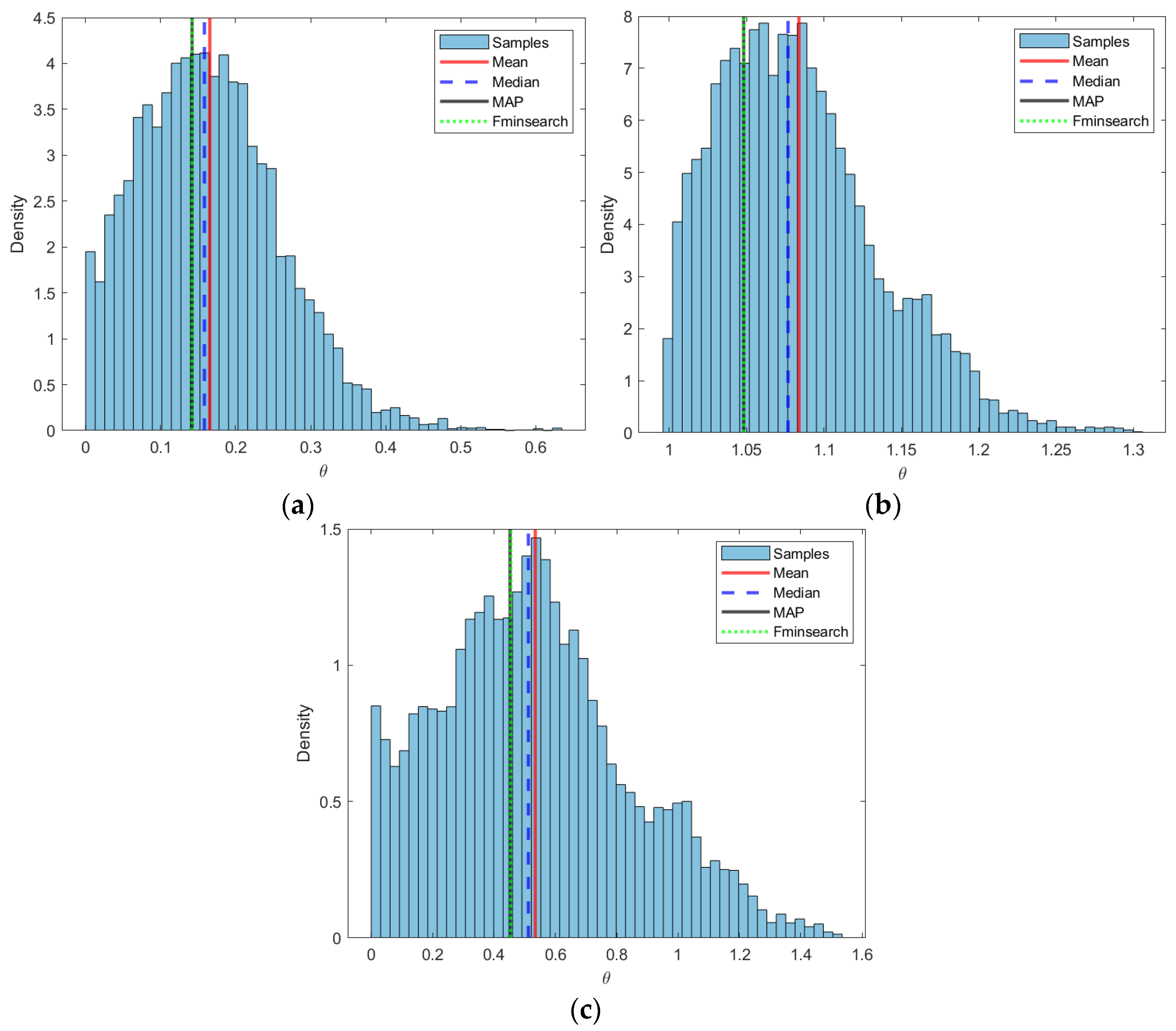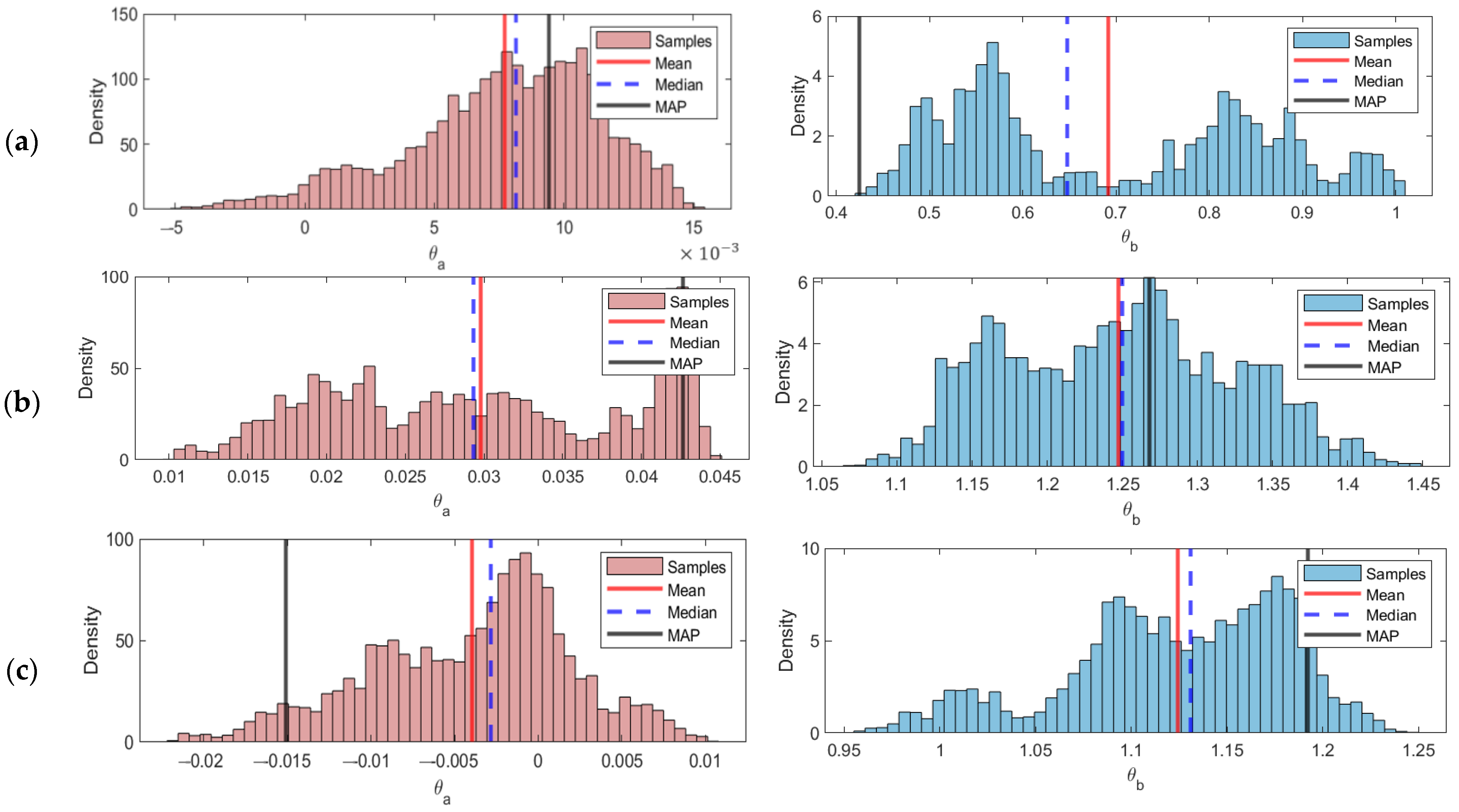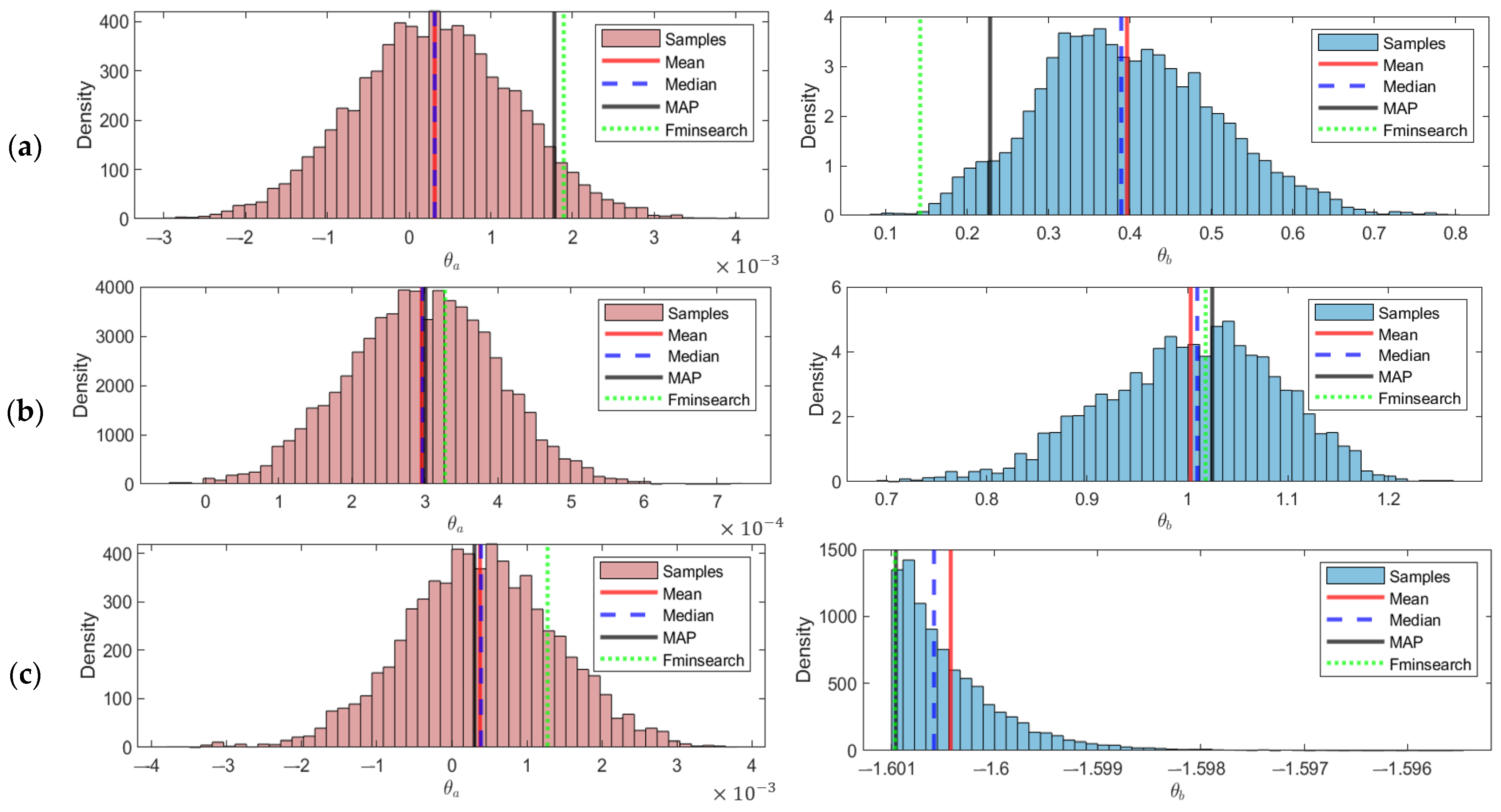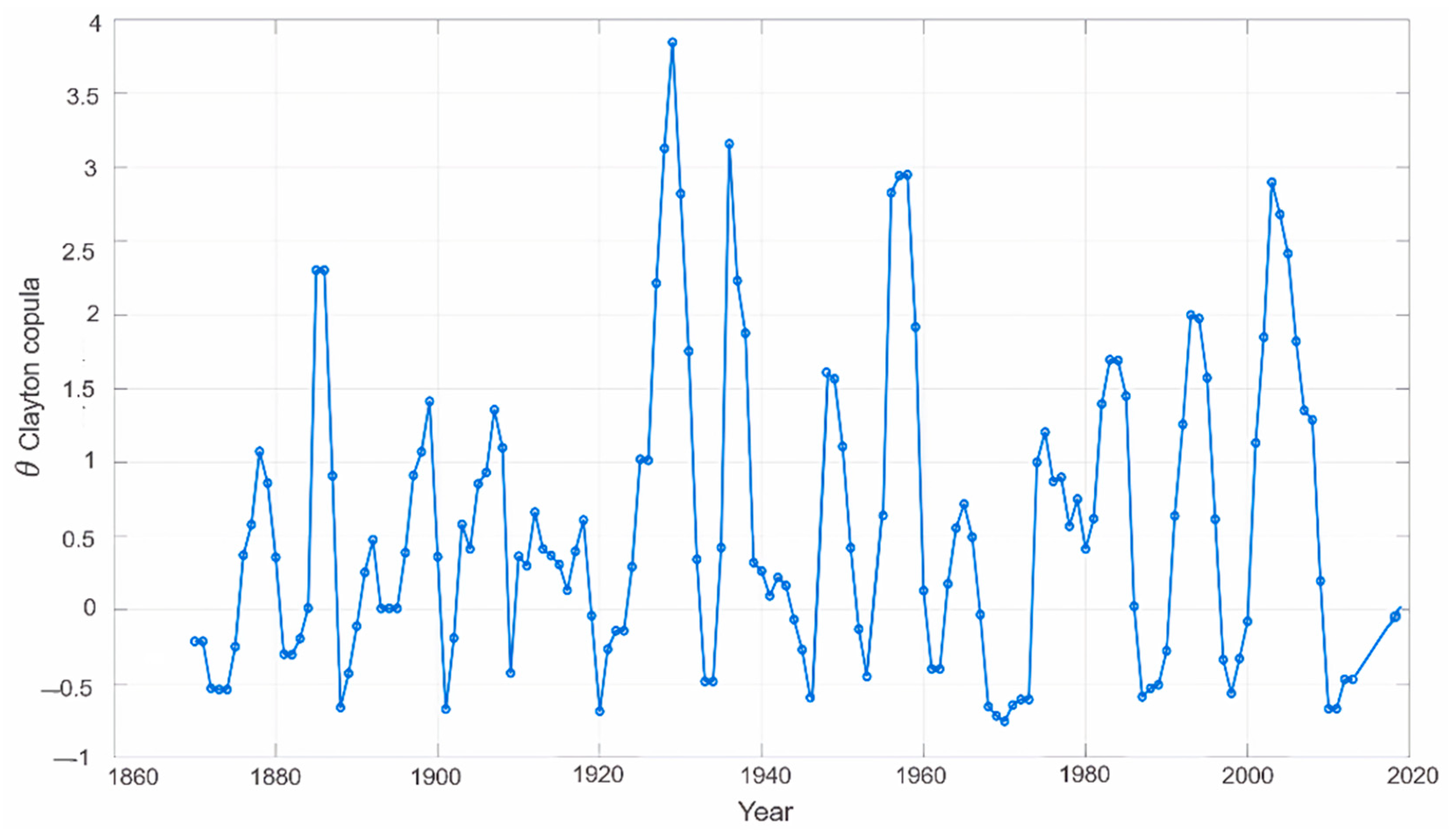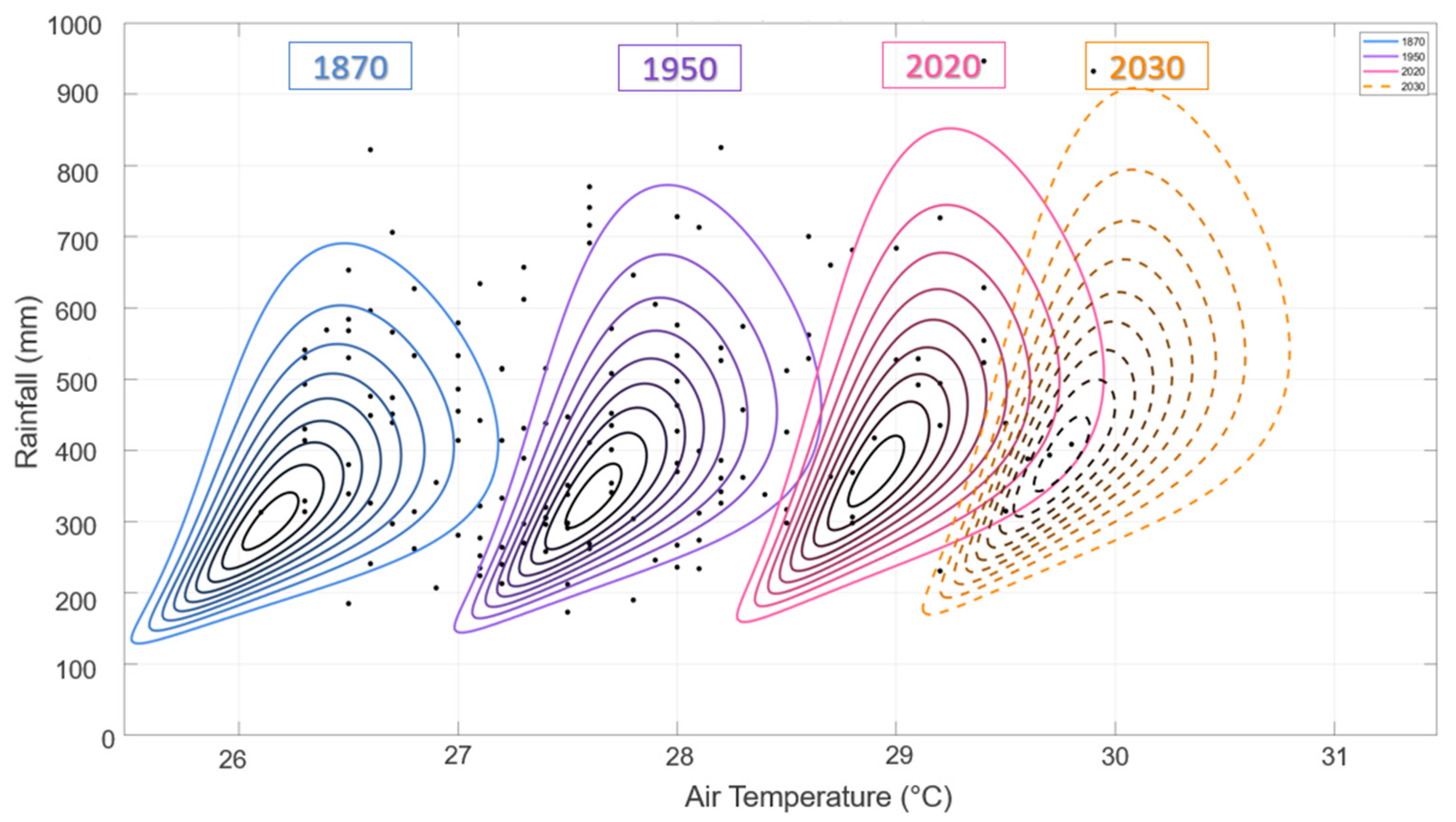4.1. Stationarity of Rainfall and Temperature
The KPSS results indicate that Jakarta’s rainfall and air temperature series are non-stationary, consistent with the graphical inspection, where both variables exhibit increasing long-term trends. According to [
45], data series can be categorized as non-stationary if they show persistent upward or downward trajectories accompanied by fluctuations, a condition clearly observed in this study.
From a climatological perspective, the steady rise in annual air temperature reflects the intensification of global warming signals at the local scale. This finding is consistent with broader evidence of temperature increases across Indonesia and Southeast Asia over the past century, attributed to anthropogenic greenhouse gas emissions. In contrast, rainfall shows higher year-to-year variability with significant deviations from the mean, which may indicate enhanced climate variability. Such variability could increase the frequency of hydrometeorological extremes, including floods and droughts during dry years.
Researchers have documented similar non-stationarity in rainfall and temperature extremes in other tropical regions. For example [
46], highlight that ENSO and IOD events strongly influence hydrometeorological extremes in Southeast Asia, which induce shifts in statistical properties over time. This external forcing complicates the assumption of stationarity and supports the application of time-varying models in climate risk analysis.
These results emphasize the methodological implications for modeling compound climate risks. If stationary models are applied, there is a risk of underestimating or misrepresenting long-term changes in rainfall–temperature dependence. By contrast, adopting non-stationary or time-varying copula approaches allows for a more accurate representation of evolving dependencies. This ensures that Jakarta’s climate adaptation and disaster risk management strategies rely on robust evidence.
4.2. Best-Fitting Marginal Distributions
The best-fitting marginal models were the Lognormal distribution for rainfall and the GEV distribution for air temperature. The time-dependent location parameters in both distributions indicate non-stationarity, consistent with the increasing trends observed in the raw series.
Researchers widely use the Lognormal distribution to model precipitation data for rainfall due to its positive support and ability to capture right-skewed behavior [
25]. Its suitability for Jakarta reflects the substantial variability of annual maximum rainfall, consistent with findings in other tropical regions where rainfall distributions often deviate from symmetry. The GEV distribution has been consistently recommended for temperature in hydrological and climatological studies [
26,
28]. The negative shape parameter
implies a bounded upper tail, suggesting that extreme annual maximum temperatures in Jakarta may have a natural upper limit. This is consistent with evaluations across Southeast Asia, where GEV margins robustly capture temperature extremes when combined with L-moment approaches [
28].
The K-S test results confirm that the transformed cdf values follow a uniform distribution on (0,1), ensuring that the marginal models are statistically adequate. This validation step is essential before applying copula models, as copula theory requires well-fitted marginal distributions to capture dependence structures [
17] accurately. These results highlight the necessity of accounting for time-varying characteristics in marginal distributions. A stationary assumption would ignore the shifting central tendencies of rainfall and temperature, potentially biasing subsequent dependence modeling. By adopting non-stationary Lognormal and GEV margins, the analysis provides a more realistic basis for copula-based joint modeling in Jakarta.
4.3. Stationary Copulas
The estimation results of the stationary copula parameters indicate that the relationship between rainfall and air temperature in Jakarta is positive but weak across all three copulas and estimation approaches. Differences in parameter values obtained through fminsearch, MCMC, and the combined fminsearch-MCMC reflect the characteristics of each method. For instance, the fminsearch approach provides more conservative initial estimates, often closer to the lower bound of the copula, while MCMC produces posterior distributions showing parameter variability and skewness. The combined fminsearch-MCMC approach leverages the strengths of both methods, producing stable estimates while accounting for posterior distribution characteristics.
The Clayton copula can better capture lower-tail dependence, which is relevant for low rainfall events accompanied by certain temperature conditions. Its parameter value, being farther from the lower bound than Gumbel and Frank, indicates that it more effectively represents the existing dependence, even if the intensity is weak. The Gumbel copula, focusing on upper-tail reliance, and the Frank copula, which captures dependence across the entire distribution, provide additional insight into the non-linear relationship between the two variables, although both also show low intensity.
This weak dependence between rainfall and air temperature may imply that the relationship between the two variables is non-linear and influenced by complex external factors. In tropical regions such as Indonesia, this phenomenon may be due to the influence of seasonal climate variability, such as El Niño and IOD, and local atmospheric dynamics that can trigger rainfall anomalies without significant temperature changes, or vice versa. Therefore, even if the statistical relationship is weak, it is still important to model it appropriately to understand the hydrometeorological dynamics in urban areas such as Jakarta. Unlike univariate designs, moderate dependence can substantially alter joint occurrence probabilities and compound return periods. Copulas (i) quantify tail-specific co-behavior (e.g., Clayton’s lower tail) that univariate fits cannot see, (ii) enable AND/OR/Kendall definitions of joint risk, and (iii) reveal time-variation in dependence
that may amplify compound hazards even when average
is small. These are key for compound-event planning (e.g., dry–cool or hot–wet combinations). Recent reviews highlight that compound-event research benefits from large-ensemble simulations to assess low-probability robust but high-impact joint extremes [
47]. In addition, new dependence metrics demonstrate that the tails of joint extremes (e.g., precipitation–wind or rainfall–temperature) may exhibit distinct behaviors critical for risk assessment [
48]. These studies reinforce our use of copula-based approaches to better capture tail-specific dependence and compound-event relevance.
4.4. Non-Stationary Copulas
The non-stationary copula parameter estimation results indicate that Jakarta’s relationship between rainfall and air temperature exhibits an increasing trend over time, although the dependence values remain low. This contrasts with the stationary model, which captures only a fixed and generally weak dependence. This difference highlights that the non-stationary model can represent temporal dynamics in the interaction between climate variables that a stationary approach cannot capture.
The Clayton and Gumbel copulas show a small but positive contribution of time to the increasing dependence in the lower-tail and upper-tail distributions, respectively. In contrast, the Frank copula indicates a slight decrease in dependence across the full distribution. These findings suggest that, although the overall relationship is weak, temperature changes are beginning to influence rainfall patterns, or vice versa. This is consistent with tropical climate dynamics, where the rainfall–temperature relationship is complex and affected by seasonal variability, phenomena such as El Niño and IOD, and local atmospheric dynamics [
47,
48].
The upward trend in dependence detected by the non-stationary model has important implications for hydrometeorological monitoring and climate change risk mitigation in urban areas. The observed increase may be an early signal of shifts in Jakarta’s local climate system, driven by anthropogenic factors such as global warming, urbanization, and natural factors [
47,
48]. Therefore, non-stationary modeling provides a more realistic representation of the interaction between rainfall and temperature and supports dynamic planning for compound-event management and hydrometeorological risk [
48].
4.5. Hydrometeorological Implications of the Selected Copula Model
The model selection results indicate that the non-stationary Clayton copula estimated using the MCMC approach is the best model to describe the dependence between rainfall and air temperature in Jakarta, as supported by the lowest AIC value compared to the other models. As reflected in the values, the time-varying dependence confirms that the relationship between rainfall and air temperature is dynamic and not constant throughout the observation period. Although the average dependence is moderate, these fluctuations are vital because they affect the probabilities of joint occurrences, which a stationary copula cannot capture.
The values are mostly positive, indicating a general positive dependence, although researchers observe slight decreases or temporary reversals in some years. Even when the average dependence is modest, these temporal shifts can significantly impact joint occurrence probabilities and compound-event risks, underscoring the importance of a time-varying copula framework. The distribution of also confirms strong lower-tail dependence, particularly under low rainfall and low temperature conditions, as reflected by the selection of the Clayton copula. This pattern indicates that dry-cool conditions were still dominant in the early observation period and began to shift gradually over time. In other words, the non-stationary model is not only statistically valid but also relevant for capturing the dynamics of climate change in the lower extremes, which are not visible in stationary models.
These results relate to the contour visualizations and the latest temporal trends. Changing trends indicate significant impacts of hydrometeorological dynamics. The consistent rise in temperature reflects global warming, while the widening rainfall distribution signals increasing uncertainty and the risk of extreme events. The finding that the Clayton copula provides the best fit indicates strong lower-tail dependence, namely low-rainfall conditions that tend to coincide with low temperatures. Climatologically, this dependence structure implies that the frequency of low-temperature droughts—which often emerge at the beginning or end of the dry season in tropical regions—may increase. Such conditions can exacerbate water scarcity and reduce soil moisture availability, affecting the agricultural sector and urban water security. Conversely, the widening rainfall distribution and sustained temperature rise also suggest a higher potential for short, high-intensity rainfall events that may trigger urban flooding. Thus, these results demonstrate a statistical relationship and carry tangible implications for the increasing frequency of extreme events in the form of droughts and floods, consistent with the literature on compound climate extremes [
49,
50]. Studies in Indonesia also support these findings: [
51] confirmed the influence of ENSO on droughts in Borneo using a copula approach. At the same time [
52], showed a shift toward dry–dry conditions during strong El Niño and positive IOD phases in Southern Sumatra. These regional climatic linkages reinforce the relevance of the present findings, highlighting that Jakarta faces increasingly complex compound-event risks under climate change.
Our analysis indicates weak-to-moderate average dependence between Jakarta’s annual-maximum rainfall and air temperature. Yet, AIC consistently favors the time-varying Clayton copula and reveals lower-tail co-variability. Even when rank dependence is modest, compound-risk literature shows that tail-focused dependence can materially shift joint return periods, underscoring the value of a bivariate approach over separate univariate analyses. This aligns with recent compound-event studies emphasizing tail metrics and multivariate risk framing [
48]. The finding that a lower-tail–sensitive copula best describes Jakarta is climatologically plausible. Jakarta has documented urban warming and a rapid expansion of built-up areas in recent decades, reshaping the surface energy balance and atmospheric stability. Such changes can alter the co-occurrence structure of temperature and rainfall extremes, including dry-cool combinations that matter for water supply and heat-stress transitions. Recent modeling and observational studies over Jakarta link LULC change with rising urban temperatures and evolving rainfall/thermal patterns, providing context for the slow drift we infer in
[
53].
The contour shapes drawn to the lower left in the early years indicate that the strong dependence between low temperature and low rainfall is still dominant in that period, and starts to change gradually over time. Thus, the non-stationary Clayton copula is not only statistically valid, but also relevant for capturing the dynamics of climate change in the lower extremes that other models, including stationary ones, do not see. Methodologically, our pairing of non-stationary margins with a time-varying copula follows the broader move from stationary design assumptions to dynamic multivariate frameworks. The copula approach isolates the dependence structure from the marginals, supports alternative joint-risk definitions (AND/OR/Kendall), and cleanly accommodates parameter dynamics
. While more flexible families exist, using one-parameter Archimedean copulas balances parsimony and interpretability given weak dependence and sample size; this echoes guidance in the hydrologic copula literature [
54]. The 2030 projections show an increase in temperature and a widening distribution of rainfall, reflecting uncertainty and increasingly complex hydrometeorological risks in the future.
Finally, our results are consistent with univariate EVT insights: GEV-type models (for temperature) often provide robust extreme quantiles across sample sizes, and recent rainfall-extreme frameworks (e.g., MEVD) emphasize uncertainty minimization—both reinforcing the need to carry margin uncertainty into joint-risk estimation. Detecting the dependence between rainfall and temperature has important practical significance, as it suggests that extreme weather events in Jakarta are likely influenced by interactions among hydrometeorological components, rather than by a single variable, thus requiring an integrated response. The patterns projected for 2030 indicate increasing challenges in managing hydrometeorological disaster risks. Therefore, this insight supports the development of climate adaptation strategies that account for compound risks. Understanding this dependence can also strengthen early warning systems and improve scenario planning. These findings may also inform spatial planning policies and the development of resilient infrastructure in Jakarta in response to changing hydrometeorological conditions.
